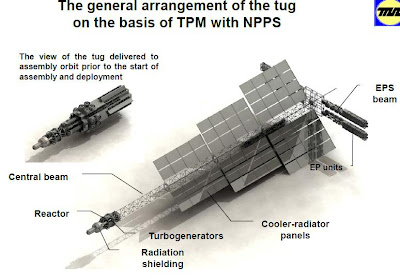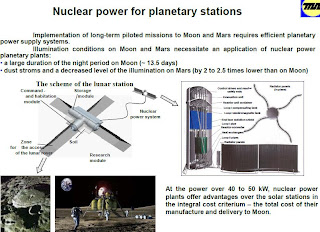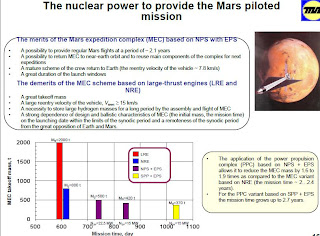The presentation discusses nuclear power sources for space up to 1 megawatt for flying to Mars, moon base power and for orbital tugs.
Koroteev also wrote “New stage in the use of atomic energy in space “
A qualitatively new stage in the development and practical application of atomic energy in space is linked with the use of multipurpose high-capacity propulsion-power modules. Their design based on a nuclear powered propulsion facility in the megawatt range has been approved and accepted for implementation. In this article, the facility is described, the principles of operation of the facility as a whole and its individual subsystems are examined, and the proposed characteristics and mass of the structural elements are presented. The advantages of using atomic energy in the power-plant–motor variant, including for manned flight to Mars, are shown.
Russia is looking closely at plasma thrusters as well
* hybrid two-contour scheme, a plasma generator driven by reactor-produced electricity yields specific impulse 20 times higher than chemical propulsion
* inner contour of the reactor with circulating working agent at 1500 C
* development started in 2010
* plans to complete initial design by 2012
* prototype working by 2015
* cargo module ready for flight in 2018
Bigger Russian nuclear space designs
In 2008, Open-cycle multi-megawatt MHD space nuclear power facility
The results of calculations of the characteristics and development of a scheme and technical make-up of an open-cycle space power facility based on a high-temperature nuclear reactor for a nuclear rocket motor and a 20 MW Faraday MHD generator are presented. A heterogeneous channel-vessel IVG-1 reactor, which heated hydrogen to 3100 K, with the pressure at the exit from the reactor core up to 5 MPa, burn rate 5 kg/sec, and thermal power up to 220 MW is examined. The main parameters of the MHD generator are determined: Cs seed fraction 20%, stopping pressure at the entrance 2 MPa, electric conductivity ≈ 30 S/m, Mach number ≈ 0.7, magnetic induction 6 T, electric power 20 MW, specific energy extraction ∼4 MJ/kg. The construction of the scheme of a MHD facility with zero-moment exhaust of the working body and its main characteristics are presented.

Brian Wang is a Futurist Thought Leader and a popular Science blogger with 1 million readers per month. His blog Nextbigfuture.com is ranked #1 Science News Blog. It covers many disruptive technology and trends including Space, Robotics, Artificial Intelligence, Medicine, Anti-aging Biotechnology, and Nanotechnology.
Known for identifying cutting edge technologies, he is currently a Co-Founder of a startup and fundraiser for high potential early-stage companies. He is the Head of Research for Allocations for deep technology investments and an Angel Investor at Space Angels.
A frequent speaker at corporations, he has been a TEDx speaker, a Singularity University speaker and guest at numerous interviews for radio and podcasts. He is open to public speaking and advising engagements.







